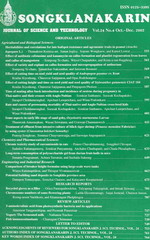ThaiScience
ThaiScience
SONGKLANAKARIN JOURNAL OF SCIENCE & TECHNOLOGY
Volume 42, No. 03, Month MAY, Year 2020, Pages 615 - 620
In vitro biological activities of thunbergia laurifolia stem and leaf with reference to rosmarinic acid
Parichart Hongsing, Chanida Palanuvej, Nijsiri Ruangrungsi
Abstract Download PDF
Thunbergia laurifolia Lindl. (Thunbergiaceae family) was shown to be a natural antioxidant source to cope with oxidative stress. By DPPH and FRAP antioxidant assays, this study found that rosmarinic acid exhibited the highest antioxidant activity followed by leaf and stem ethanolic extracts of T. laurifolia. By intracellular anti-oxidation assay against H2O2-induced ROS in EA.hy926 endothelial cells using 2′,7′-dichlorodihydrofluorescein diacetate as a probe, all tested samples exhibited marginal protection, i.e. T. laurifolia leaf extract (77.31±0.66%), rosmarinic acid (88.10±6.105%), and T. laurifolia stem extract (91.30±0.86%), compared to the control (100%). Cytotoxicity against five cancer and two normal cell lines were evaluated by MTT cell viability assay. Rosmarinic acid and the leaf extract inhibited cell viability selectively in each cell line, whereas the stem extract revealed no cytotoxicity (IC50≥100 μg/mL) in any of the cell lines
Keywords
Thunbergia laurifolia, rosmarinic acid, reactive oxygen species, antioxidant activitySONGKLANAKARIN JOURNAL OF SCIENCE & TECHNOLOGY
Published by : Prince of Songkla University
Contributions welcome at : http://rdo.psu.ac.th
